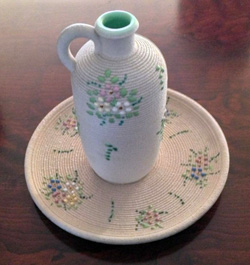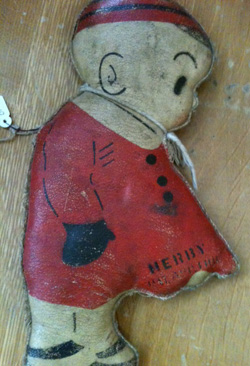 |
|
|||||||||||||||
 |
 |
|||||||||||||||
RINKER ON COLLECTIBLES — Column #1407 Copyright © Harry Rinker, LLC 2014
Questions
and Answers
ANSWER: When training antiques and collectibles auctioneers, collectors, dealers, and others, I stress the need to learn authenticating vocabularies. These vocabularies, focusing on changes that occur over time, include, but are not limited to, color, construction, form, manufacturing quality, material, pattern, shape, size, and weight. They are essential to dating unmarked or partially marked objects. The soft pink pastel tones of your matching vessel vase and plate indicate a 1950s origin. The shape of the vase and the “Italy” marking further confirm this date attribution. “1391” is a stock number. The quality of the piece suggests the piece was made for sale in a low- to middle-end department store, gift shop, or mail catalog. The set is one of millions of ceramic pieces that flooded the American market in the 15 years following the end of World War II. Ceramic manufacturing was one of the easiest industries to restore. Your matching vase and plate has decorator value, primarily because it is pretty and might evoke some conversational interest. It has no collector or reuse value. Its secondary market retail value is between $20.00 and $25.00. I considered a possible fit in the current “Modernism” market, but concluded the vase is “too cute” to qualify. Kitsch and cute are two different entities. QUESTION: I have eight prints of old Philadelphia taverns, among which are the Black Horse Inn Yard, Drawbridge and Blue Anchor Inn, Falstaff Inn, Indian Queen Hotel, and Spread Eagle Inn. Each print has a short history of the tavern on the back. The prints measure 18 inches by 20 inches, are marked “J. P. / 1908’ in the lower right corner, and appear to be distributed by a Philadelphia brewery. The prints have been in my family since the 1940s. Do they have any value? – PR, Reading, PA, Email Question ANSWER: Although I answered a similar inquiry in 2008, I decided to revisit the question to see if I could make a complete list of the 12 prints in the series and find biographical information about JP (James Preston). In 1909, the Robert Smith Ale Brewing Company, owned by Schmidt’s Brewery of Philadelphia, commissioned James Preston to prepare a series of 12 prints of historic taverns in the greater Philadelphia area. The prints were done in a Dickens style, similar to the artwork found on Royal Doulton’s Dickens ware and Buffalo Pottery’s Deldare ware. The prints in the series include:
James Moore Preston (1873-1962), artist and illustrator, trained under Thomas Anshutz at the Pennsylvania Academy of Fine Arts in Philadelphia. James and his wife May Wilson Preston (1873-1949), who was trained at Oberlin Art School in Ohio, were linked to members of the Ashcan School of painters. May was influenced heavily by Robert Henri and John Sloan. James was close to William Glackens. James and May were included in Henri’s 1911 exhibition at the Union Club and took part in the 1913 Armory show. The couple lived in New York and often traveled to Paris. Preston did a cover for the “Saturday Evening Post” in April 1905. However, his most active illustration period was during the 1920s. For more details, see: http://rogallery.com/Preston_James_Moore/Moore_Preston-biography.html. The dealer asking price for a Preston’s Robert Smith Ale Brewing Company Philadelphia tavern print ranges from $125.00 to $175.00. These values reflect a print that has been framed and matted. When valuing a print, two values are involved: (1) what is the value of the print unframed and (2) what increase in value does the frame and matting represent. The latter usually represents a minimum of 50 percent of the final value. Condition and location are two other key factors in determining value. Any damage to the prints reduces their value by 50 percent or more. Although sale to a breweriana collector will add a slight premium, sale in the greater Philadelphia market would add between 25 and 40 percent to the value. If unframed and in fine or better condition, your prints have a value between $35.00 and $45.00 each. If matted with acidic matboard and backing and an ordinary frame, value jumps to $60.00 to $75.00. Matted in acid-free (museum) matboard and in a quality frame, a value in the $100.00 range is possible. QUESTION: My dad has some old Elvis decanters in their period boxes. One bottle is colored, the other is gold. What are your thoughts about their value? – MM, Email Question ANSWER: “The King is dead. Long live the King.” Alas, Elvis is dead and so is the secondary market for his collector edition whiskey decanters. The only question remaining is: how low can the prices go? A quick check of eBay.com shows over 200 Elvis decanters available for sale. While one overly optimistic dealer is asking a Buy-It-Now price of $125.00 for the “1977 Elvis Presley Ultimate Tribute McCormick Decanter/Music Box,” comparison shopping reveals other examples priced below $50.00. Even the cheaper examples are not selling through. One seller trying his best to generate a bid opened one of the painted McCormick “limited edition” music box Elvis decanters at $9.99. It failed to attract a bid. Every Elvis collector who wanted an Elvis decanter has acquired one. There are few to no new Elvis collectors entering the secondary market. At this point, if someone offered you $35.00 or more for the two Elvis decanters, I recommend taking the money. Any money is better than no money. READER’S RESPONSE—“PAL” IDENTIFIED: In “Rinker on Collectibles” #1393, I answered an email question from BP about a leather toy dog that measured 8in from the tip of its nose to the tip of its tail, had a black and white body, and “PAL” marked on its collar. Although able to date the leather toy dog to the mid-1920s, I was not able to specifically identify the dog and asked my readers for help. Jim Tyne of DeKalb, Illinois, sent me an email dated January 4, 2014, that reads: “I just read your column in the January 2014 edition of ‘Yesteryear,’ a monthly advertising magazine published in Princeton, WI…..Pal was Skeezix’s pal [dog] from the Gasoline Alley comic strip. ‘Walt & Skeezix,’ Volume 1 of a compilation of Frank O. King’s 1925 and 1926 comic strips, was published by Drawn & Quarterly in 2007….In the introductory material is an article on some of the Skeezix items for sale during the early days of the strip. Pages 31-32 show the Pal toy. Also shown is a sit up version of Pal which, according to the article, may be a prototype or knockoff. The toys were made by Live Long Toys of Chicago and sold around 1926.” Cartoonist Frank King created Gasoline Alley. It first appeared in the Chicago Tribune’s “The Rectangle” as a single panel in which Avery, Bill, Doc, and Walt talked about automobiles. The daily comic strip began on August 24, 1919, in the New York Daily News. The continual aging of the characters was one of the strip’s unusual features. On February 14, 1921, Walt Wallet, a bachelor, found a baby abandoned on his doorstep. Walt named the baby Skeezix (cowboy slang for a motherless calf). In the December 23, 1922 strip, Grandma Wallet presented Skeezix with an Airedale pup named Pal, modeled after King’s son Robert’s Airedale. In 1925, The Reilly and Lee Company of Chicago published “Skeezix and Pal,” a hardcover cartoon compilation of the Skeezix and Pal strips.
Harry L. Rinker welcomes questions from readers about
collectibles, those mass-produced items from the twentieth and twenty-first centuries.
Selected letters will be answered in this column.
Harry cannot provide personal answers.
Photos and other material submitted cannot be
returned.
Send your questions to: Rinker on Collectibles, 5955 Mill
Point Court SE, Kentwood, MI 49512.
You also can e-mail your questions to
harrylrinker@aol.com.
Only e-mails containing a full name and mailing address
will be considered.
You can listen
and participate in
WHATCHA GOT?, Harry’s
antiques and collectibles radio call-in show, on Sunday mornings between 8:00 AM
and 10:00 AM Eastern Time.
If you
cannot find it on a station in your area,
WHATCHA GOT?
streams live on the Internet at www.gcnlive.com.
SELL, KEEP OR TOSS?: HOW TO DOWNSIZE A HOME,
SETTLE AN ESTATE, AND APPRAISE PERSONAL PROPERTY
(House of Collectibles, an imprint of Random House Information Group, $17.99),
Harry’s latest book, is available at your favorite bookstore and via
www.harryrinker.com.
|
||||||||||||||||
 QUESTION: I own an urn-like vase that rests on a matching plate. The vase stands 8 ¾” high and is 3 ¼” wide at its widest part. The plate is 9 ½” in diameter. The vessel is marked “Italy / 1391” on the base. What information can you provide? – CM, Reading, PA, Email Question
QUESTION: I own an urn-like vase that rests on a matching plate. The vase stands 8 ¾” high and is 3 ¼” wide at its widest part. The plate is 9 ½” in diameter. The vessel is marked “Italy / 1391” on the base. What information can you provide? – CM, Reading, PA, Email Question A Skeezix leather stuffed toy accompanied the Pal leather stuffed toy. While the Skeezix toy closely resembles the cartoon character, the Pal toy does not. The Pal toy looks more like a terrier than an Airedale.
A Skeezix leather stuffed toy accompanied the Pal leather stuffed toy. While the Skeezix toy closely resembles the cartoon character, the Pal toy does not. The Pal toy looks more like a terrier than an Airedale.